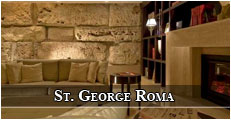Navona Square (Piazza Navona)
The history of the square goes back to Ancient Rome. In this area rose the large Circus of the Emperor Domitian. As a matter of fact the vast elliptical shape of the square matches exactly the outlines of the circus. Here were carried out mock sea battles, grandiose public shows, games etc. In the following centuries, although the complex fell into ruins, the site was still a favourite spot by the Romans.
In the Middle Ages several festivals took place in this square in Rome, it was used for jousting, horse-racing, and water festivals. During the latter, which often took place in the stifling dog-days of August, the piazza was flooded and Rome’s aristocracy had their gilded carriages pulled around the artificial lake, while throwing money on every hand in order to increase popular gayety.
These days, December still sees the great Christmas’ market, a means by which the square’s old festive is kept alive. The square, with its fountains, the church of S.Agnese, Palazzo Pamphilj and the buildings that surround it, was already constructed between the 1600’s and 1700’s. Since then nearly nothing has been changed and this is the secret that characterizes the square. Pope Innocent X began to arrange the public square, till that moment dirty and neglected, with the reconstruction of Palazzo Pamphilj commissioned to Girolamo Rainaldi. The grandiose palace with its simple mass gave immediately a distinguished look to the square, to which were added later other constructions. The interiors are noteworthy for the decorations of the hall with frescoes by Pietro da Cortona, famous artist from Florence. The Pope commissioned also the church of S. Agnese, on the place where the saint endured the martyrdom. In the Middle Ages a church had been already built on the walls of the Circus. The ruins of which are still visible under the new church. The church was designed by Borromini (1645-50). The artist was particularly criticized and mocked for the baroque concave and convex lines of the façade, for the lightness of the campaniles and the cupola, and for the completely new conception of the whole building. The most pitiless of his critics was his eternal rival Bernini. The artist, sensible and weak, suffered so much from the never ending critics who committed suicide. The interior of the church is by Carlo Rainaldi, richly decorated in conformity with the baroque spirit. Pope Innocent X was buried here. Once completed the square, the Pope continued to embellish it with the construction of two fountains. One of these, masterpiece by Bernini, is the central Fountain of the Rivers (Fontana dei Fiumi). On the group of rocks sit the giants symbolizing the rivers of the four Continents: the Nile, the Ganges, the Danube and the River of the Plata. On top of it raises the obelisk dating from Domitian’s reign. The other fountain in front of Palazzo Pamphilj, is the Fountain of the Moor. The third Fountain, to the other side of the square is a recent work of the XIXcent.
Today the square is surrounded by characteristic coffees and wine-bars, in the center of the square the painters expose their works, and the Romans, adults and kids, come to take a walk creating an indissoluble harmony between art, history and true life.
MAIN DISTANCES HOTEL <–> NAVONA SQUARE
St.George Hotel – Navona Square: 0,7 Km (0,4 miles)
Crowne Plaza Rome – St.Peter’s Hotel – Navona Square : 5 Km (3,1 miles)
Don’t miss a Navona Square visit by staying at St.Geroge Hotel 5 star Luxury Hotel in Rome.
Crowne Plaza Rome Hotel is a ideal location for those who are planning a event in Rome.




